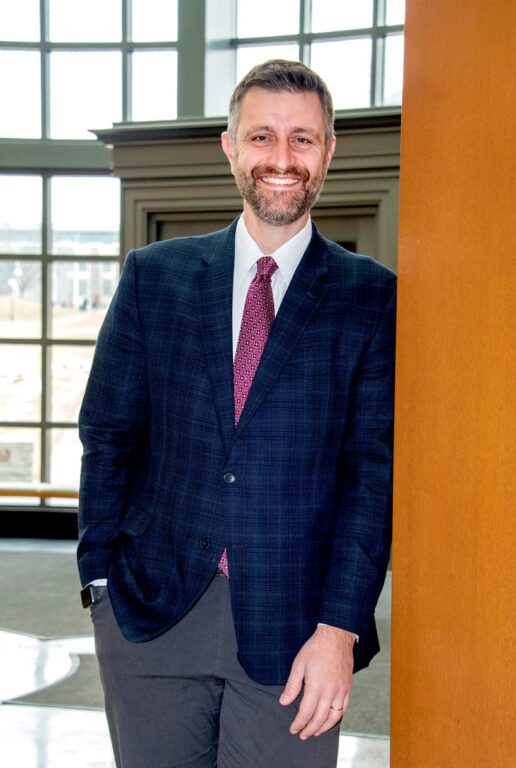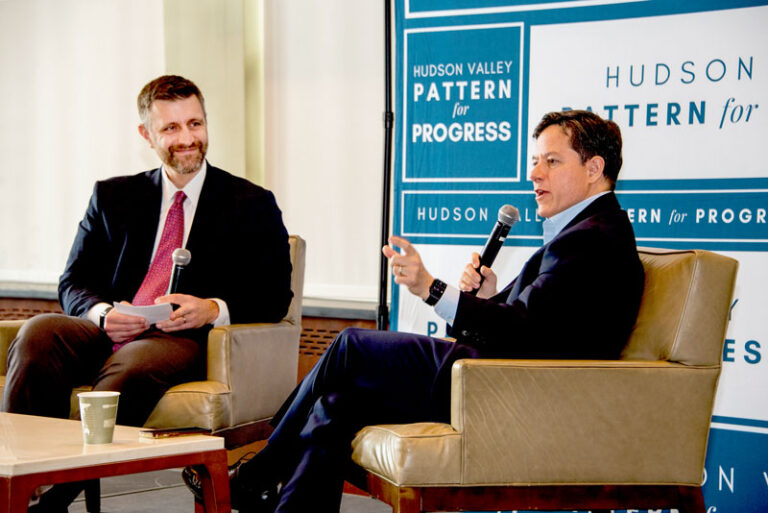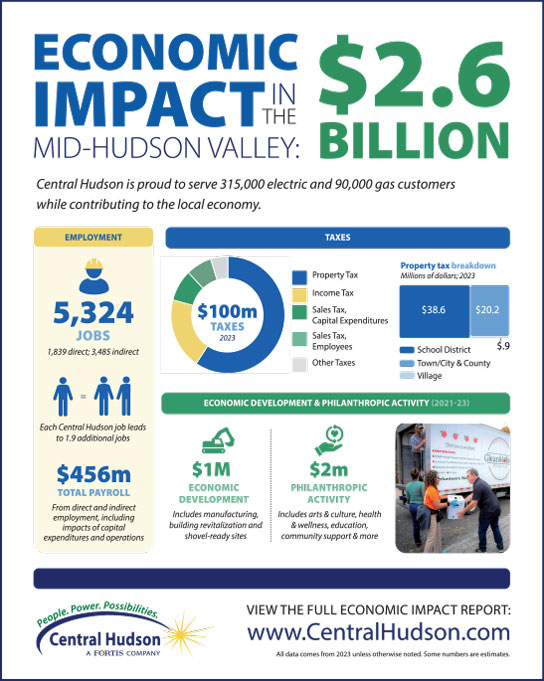Driving solutions on the pressing issues
HV Mfg sat down with Adam Bosch, President & CEO of Pattern for Progress, to discuss his career path and the organization’s role in shaping the Hudson Valley’s future. With a background in journalism and public policy, Bosch has built a career on uncovering facts, translating complex issues into actionable insights, and driving solutions to some of the region’s most pressing challenges.
At the helm of Pattern for Progress, he leads efforts to tackle housing, workforce development, infrastructure, and economic policy—connecting the dots between data and decision-makers. Bosch shares his journey from investigative reporting to regional leadership, why research alone isn’t enough to drive change, and how Pattern’s work is shaping a more sustainable and prosperous Hudson Valley.
This year, Pattern celebrates its 60th anniversary of advancing regional solutions. The Council of Industry is proud to have been a founding member of this vital organization and is happy to help celebrate its achievements past, present and future.

HV Mfg: Thanks for agreeing to speak with us – let’s start with your background. Tell us a little about how you got to Pattern?
AB: I’ll tell the longish version. My educational background is in engineering and journalism, but mostly in journalism. I worked as a journalist for almost 15 years—mostly locally, including at the Times Herald-Record and The New York Times in Albany. In 2012, I was looking to use those skills in a different context and that’s how I came to Pattern for the first time. I was here for a single year as Vice President of Research. During that time, I worked on several reports, including an award-winning report on Rockland County’s budget deficit and the first edition of Closed Schools, Open Minds.
HV Mfg: That’s right, this role is almost full circle, where did you go after leaving Pattern in 2013.
AB: I went to work at the New York City water supply system for almost 10 years. I was their first public affairs and education director for the reservoir system north of the city. I spent a lot of time communicating with stakeholders and explaining the operational, protection and maintenance of the largest municipal water supply in the United States. It taught me how to make data-heavy subjects accessible to different audiences, whether that’s government officials, businesses, or the general public. And that’s exactly what we do at Pattern for Progress: gather data, analyze trends, and then communicate our findings in ways that help leaders and communities make informed decisions.
HV Mfg: How did you end up back at Pattern for Progress as CEO, and how has your background influenced your approach?
AB: When the former CEO announced he was leaving, I wasn’t initially thinking about applying. But the day the news came out, I got five text messages from different people saying, “Hey, you’d be good at that—you should think about it.” At first, I thought it was just a coincidence. But by the fourth or fifth message, I started digging into it.
Ultimately, I applied because of that encouragement. And when I reflected on why people thought I’d be a good fit, I realized it made perfect sense. The work Pattern does is very similar to what I did in journalism: find the facts, vet them thoroughly, package them in a way that’s digestible, and present them in a way that moves people to act.
In journalism I learned that you can’t go into a story with preconceived notions—you have to let the facts tell the story. We follow the data, vet it rigorously, and ensure that our recommendations are based on real evidence—not politics, not assumptions, and not what people want to hear, but what the facts support. That commitment to following the evidence—wherever it leads—is what makes Pattern’s work so valuable to the region.
HV Mfg: How has the transition been?
AB: I’d say the transition has gone well. One of the first things I did was look back at Pattern’s original articles of incorporation, which define its mission. They were written in a way that still holds up today—conducting research on regional challenges, doing that research without political aims or affiliations and promoting regional, countywide and local planning to improve quality of life. Our job now is to take those principles and apply them to today’s challenges, whether that’s housing, infrastructure, transportation or economic development.
I’ve focused on making sure our research is timely, relevant, and actionable. That means not just publishing reports but also following up—talking to policymakers, engaging with communities, and making sure that our research points toward real actions. For example, our housing reports have influenced local and state discussions, and our research on water infrastructure has pushed funding efforts forward.
HV Mfg: You’ve said that getting information out there in a meaningful way takes more than just a well-written report or an email blast. Can you elaborate on that?
AB: Absolutely. I burn a lot of tire rubber and shoe leather because simply publishing a report isn’t enough. I don’t want to offend anyone, but the reality is that people don’t read the way they used to. They’re bombarded with information from all directions, in every format imaginable. We could put out the most well-researched, well-written 40-page report, but that alone isn’t what starts conversations or drives change.
What moves the needle is direct engagement—getting in front of the right people and having meaningful conversations. When I can explain the research in a way that resonates with their real-world challenges, that’s when they start to engage.
That said, the research still plays a critical role—it’s the foundation for everything. The report itself may not be the catalyst, but it gives us the substance we need to craft compelling presentations and frame discussions in a way that makes the issue feel real and urgent. Once we’ve captured their interest and shown them why it matters, then people will go back to the report, dig deeper, and appreciate the detail.

“Getting in front of the right people and having meaningful conversations. When I can explain the research in a way that resonates with their real-world challenges, that’s when they start to engage.”
HV Mfg: How has Pattern’s research changed over time.
AB: Like I said earlier, Pattern was founded with three main objectives and those objectives still hold true today. Specific topics might change—transportation in the past might have meant Stewart Airport and Metro-North, while today it includes electric vehicles and microtransit. Housing discussions used to be about sprawl, but now they’re about affordability and walkability. The core mission stays the same, but how we apply it evolves with the times.
The work we do is driven by what I call a spirit of service—not just acting as a think tank that collects and publishes information, but as a true partner in turning research into action.
HV Mfg: I love that and know it to be true, but that can’t be easy, how do you approach that?
AB: A big part of that approach is captured in the phrase “Talk with you, not at you.” That idea actually comes from something I used to hear on ESPN Radio back in the late ’90s and that always stuck with me because it reflects the kind of communication I value — engaging people in conversation rather than just broadcasting information at them.
For example, we recently completed a study on childcare challenges in the region. Instead of just publishing it and moving on, we’re actively meeting with policymakers and stakeholders and helping them think through solutions. We are talking with them, not at them.

HV Mfg: In what other ways does Pattern for Progress intersect with manufacturing in the Hudson Valley?
AB: Manufacturing is deeply connected to several of the biggest challenges we work on—workforce development, housing, infrastructure, and even childcare. If you want to have a successful business in this region, you need workers. But the reality is that the regional workforce is steadily shrinking due to socioeconomic and demographic trends. That leads directly to broader issues like where those employees will live, how they’ll get to work, and whether they have access to the support systems that make working possible.
Take housing, for example. If we don’t have a full spectrum of housing options across all income levels, then we won’t have places for workers to live. It’s not just apartments or single family homes – the real need is for a full range of options at different price points. Without that variety, we limit who can afford to live and work here, creating a direct workforce issue for manufacturers.
Infrastructure is another critical factor for manufacturers, both water and power. High-quality, reliable water is essential for everything from cooling systems to production processes. But that water is only available if the infrastructure to collect, treat, and deliver it is well-maintained. The same is true for power. Manufacturers depend on stable, consistent energy to keep their operations running efficiently. When either system is outdated or failing, production suffers. That’s why we advocate for capital investment in infrastructure upgrades—because without reliable water and power, manufacturing can struggle.
HV Mfg: Absolutely. In addition to the partnership with the Council and our members, Pattern for Progress is known for bringing people and organizations together to solve regional challenges. Can you share an example of how you facilitate partnerships and drive collaboration?
AB: Sure. One example is transportation. Businesses in the region often struggle to fill jobs, not because people don’t want to work, but because they can’t get to locations that have job openings. Many potential employees don’t have a driver’s license, and our public transportation system isn’t built to connect them to key employment hubs like iPARK, Legoland, Woodbury Common, or manufacturing companies.
That’s why we’re paying close attention to innovative solutions like the on-demand microtransit system that Putnam County is piloting. The new form of public transit will likely be more efficient and effective than traditional fixed-route bus systems. Our job is to connect the dots—to highlight solutions that are already working in one part of the region and help other communities see how they could adapt them to meet their own needs.
HV Mfg: Speaking of workforce and workforce challenges, you’ve mentioned that young adults face a lot of pressure about career pathways, what advice do you have for students or graduates looking ahead?
AB: I taught at SUNY New Paltz for about 10 years, mostly juniors in their first year of major coursework in journalism. My class was investigative reporting, which was one of the more intensive courses. The class required students to go out and interview people—so it was a big shift from classroom learning to journalism fieldwork. I saw firsthand that many students reached that point in their major and realized they didn’t actually want to do it. Every semester, I had students come to me—sometimes in full panic mode—saying, “Being in this class made me realize I don’t want to be a journalist. But now I feel like it’s too late to change paths.”
HV Mfg: We hear that all the time, there’s a lot of pressure on students, what was your advice?
AB: I told my students take a notebook, go down to the rail trail, take a walk, and when you find a bench, sit down and make two lists—a list of your talents and a list of your interests. Because they are not the same thing.
For example, I was talented at engineering, but I left engineering school because I wasn’t that interested in it. On the flip side, I’m interested in basketball, but I’m not talented enough to play in the NBA. But somewhere at the intersection of your talents and your interests, there is a body of jobs. And those jobs are where you’ll thrive—because they match what you’re good at and what you love doing.
This advice really gave the students new energy and enthusiasm about their futures. They would come back with all kinds of new ideas for the careers and professions that they might want to pursue. Some of my students went on to careers totally outside journalism—nursing, politics, teaching—because someone helped them to think beyond the college path they chose when they were 17 years old. It’s really unfair that we force young people to choose their careers so early, before we’ve made any reasonable attempt to expose them to the hundreds of options that might match their talents and interests.
HV Mfg: We completely agree, sometimes the ability to change directions is critical. Tell me a little more about your leadership perspective – how do you approach your role at Pattern?
AB: For me, there’s a little bit of an ethical bend to leadership. It means being responsible, fair, honest, thorough and accurate. More than anything, I try to do my work with a spirit of service and an open mind. Leadership is not about grand gestures; it’s about showing up every day, doing the work, and acting in the way I’d want everyone to act, working in a way I’d want everyone to work – which means working hard and complaining very little.
HV Mfg: What kind of leadership behaviors do you try to model?
AB: I learned one of my earliest lessons in leadership during my first big newspaper job. If someone called in to criticize a story that we knew was factual, we had editors who wouldn’t back down. Two in particular—Adrianne Reilly and Paul Brooks—stood out to me. If someone called to complain, they wouldn’t brush it off or shift blame. Instead, they’d grab a notebook and say:
“Okay, let’s go through every single fact in this story. Show me exactly where we got it wrong and provide me with evidence.”
Most of the time, the person on the other end would freeze up, not expecting that level of accountability. They were upset that we found and reported the facts, and our editors were willing to stand up for work that was well reported and fact-checked. That experience taught me that leadership isn’t about passing the buck—it’s owning your work, standing behind your team, and being willing to defend it.
Leadership isn’t about passing the buck — it’s owning your work, standing behind your team, and being willing to defend it. Leadership is not about grand gestures; it’s about showing up every day, doing the work.
HV Mfg: You’ve faced some personal challenges, including being a two-time cancer survivor. How has that experience shaped your perspective and leadership?
AB: I don’t talk about it often, but I’ve battled cancer twice—first a blood cancer in college and then a rare cancerous tumor in my neck during my first few months as CEO at Pattern for Progress. Going through that changes how you see everything. It forces you to be responsible for your own outlook, to be honest about what you can and can’t control, and to stay as fair and kind as possible, even on the hardest days.
More than anything, it reinforced what I already believed about leadership and life: work hard, don’t complain, and stand by your decisions. When you’re in a fight like that, you don’t waste energy on excuses.
When I rang the bell after my final cancer treatment, it didn’t feel like the finish line. It felt like the starting bell. Like an engine revving up. It was a reminder that you don’t get unlimited time, so you better make the most of what you’ve got.
HV Mfg: Thank you for sharing your story.



